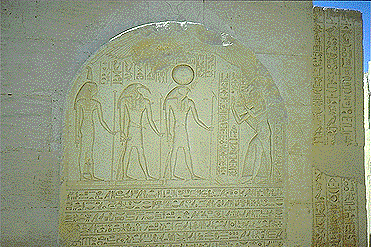Institute of Egyptian Art & Archaeology
Saqqara - Tomb of General Horemheb

Stela from the Memphite Tomb of Horemheb.
Horemheb began construction on this tomb when he was a general under kings Tutankhamun (c.1332-1322 B.C.E.) and Ay (c.1322-1319 B.C.E.). This tomb is in the necropolis of Saqqara, south of the Step Pyramid, and it was still under construction when he succeeded Ay as king. Then, of course, Horemheb began construction of a new tomb for himself in the Valley of the Kings.
This round-topped stela in the forecourt has a winged sun disk spreading its protection over the scene below. Horemheb (far right) offers to the gods (from left to right) Maat, Thoth, and Re-Horakhty. Horemheb's linen garment flares beyond his arms and legs as he bows and raises his arms in reverence before the deities. The depiction of his body reveals the continuing influence of the naturalistic Amarna style. Notice his rolls of flesh, round belly, and thin limbs.
The deities reflect the traditional style of representation with the slender waist and broad shoulders. Each stands on a small plinth, and each holds in the right hand anankh, the hieroglyphic symbol for life. Maat, goddess of truth, order, and the harmony of the universe, is on the far left. Her headdress is the single feather of truth, and the staff in her left hand has a papyrus blossom finial, probably symbolizing prosperity/beneficence. Thoth, god of wisdom, writing, and the moon, has the body of a man and the head of an ibis. He holds in his left hand a wasscepter, symbolizing dominion. Re-Horakhty (Horus as god of the sun) has the body of a man and the head of a falcon. He also holds in his left hand a was scepter.
The sunk relief hieroglyphs carved on this limestone stela are beautifully executed and indicative of the flexibility of the written language. Above and within the figures are vertical columns of hieroglyphs to be read from right to left. The direction to read is determined by which way the birds/animals/humans face. The horizontal lines of hieroglyphs below the scene are also to be read from right to left and consist of an adoration of the setting sun.
